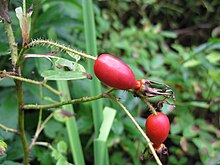Needle rose
| Needle rose | ||||||||||||
|---|---|---|---|---|---|---|---|---|---|---|---|---|

Needle rose ( rosa acicularis ) |
||||||||||||
| Systematics | ||||||||||||
|
||||||||||||
| Scientific name | ||||||||||||
| Rosa acicularis | ||||||||||||
| Lindl. |
The needle rose ( Rosa acicularis ) is a species of rose ( Rosa ) plant within the rose family (Rosaceae). The wide distribution area is the Holarctic .
description
Vegetative characteristics
The needle rose grows as a shrub and reaches heights of 1 to 3 meters. The bark of the stem-round, slightly curved branches is red-brown or purple-brown and bare. With a length of up to 4 millimeters, the sparsely to densely arranged spines are fine, stem-round, straight and widen to a narrow base.
The alternately arranged leaves are divided into petioles and leaf blades and a total of 7 to 14 centimeters long. The leaf stalk and the leaf rhachis are hairy glandular and downy and sparsely prickly. The imparipinnate leaf blade contains three, five or seven pinnate leaves. The leaflets are 1.5 to 5 centimeters long and 0.8 to 2.5 centimeters wide, elliptical or oblong with an almost rounded or rarely broad-wedge-shaped base and a pointed or rounded-blunt upper end. The edge of the leaflets is single or indistinct double sawed. The underside of the pinnate leaves is downy hairy with raised central and lateral nerves and the upper side is bald with slightly concave central and lateral nerves. The fluffy on the bottom hairy stipules are grown on a large part of its length with the petiole; the free part is broadly ovoid with a pointed upper end and a glandular serrated edge.
Generative characteristics
The flowering period in China extends from June to July. The flowers stand alone or in twos or threes in clusters. The supporting sheet is egg-shaped or lanceolate-egg-shaped with a pointed or tailed upper end and a glandular sawed or incised edge. The dense glandular downy hairy pedicel is 2 to 3.5 centimeters long.
The slightly fragrant, hermaphrodite flowers are 3.5 to 5 centimeters in diameter and have radial symmetry and five-fold with a double flower envelope . The mostly bald, rarely glandular downy hairy flower cup (hypanthium) is ellipsoid. The five leaf-like sepals are lanceolate with a smooth edge; they are downy hairy on the underside, glandular and sparsely provided with bristles and densely downy hairy on the top. The five free petals are obovate with a broad, wedge-shaped base and an edged upper end. The color of the petals is pink to magenta with a white center or rarely white. There are many stamens present. The free fluffy hairy styles are shorter than the stamens.
The five upright sepals are also present on the ripe rose hip. The shiny, bald or rarely glandular rose hips , which are red when ripe, are pear-shaped, long-ellipsoidal or obovate with a distinct collar with a diameter of 1 to 1.5 centimeters.
The basic chromosome number is x = 7; there are populations with different degrees of ploidy with chromosome numbers of 2n = 28, 42, 49 or 56.
Occurrence
The original distribution area of the needle rose extends in the temperate areas of the northern hemisphere to the northernmost regions of North America and Eurasia . There are sites in Canada , Alaska , Scandinavia , Russia ( Primorye , Kamchatka , Siberia ) Kazakhstan , Kyrgyzstan , Korea , Mongolia and in the Chinese provinces of Heilongjiang , Hebei , Gansu , Jilin , Liaoning , Shanxi , Shaanxi , Nei Monggol as well as Xinjiang and the Japanese islands of Hokkaidō and Honshu .
Systematics
The first description of Rosa acicularis was in 1820 by John Lindley in Rosarum Monographia 44-45, Plate 8. Like many Rosa species, Rosa acicularis is very variable, therefore several subspecies and varieties have been described, they are difficult to distinguish and there are transitional forms, therefore will treated as synonyms by some authors. Synonyms for Rosa acicularis Lindl. for are: Rosa fauriei H.Lév. , Rosa gmelinii Bunge , Rosa granulosa R. Keller , Rosa korsakoviensis H.Lév. , Rosa sichotealinensis Kolesn. , Rosa acicularis var. Albiflora X.Lin & YLLin , Rosa acicularis var. Glandulifolia Y.B.Chang , Rosa acicularis var. Glandulosa T.N.Liou , Rosa acicularis var. Gmelinii (Bunge) CAMey. , Rosa acicularis var. Pubescens T.N.Liou , Rosa acicularis var. Setacea T.N.Liou .
Use as an ornamental plant
This very hardy wild rose is frost hardy to −40 ° C ( USDA zone 3 ).
literature
- Gu Cuizhi, Kenneth R. Robertson: Rosa acicularis , p. 339 - the same text online as the printed work , PDF 4.6 MB , In: Wu Zheng-yi & Peter H. Raven (Eds.): Flora of China , Volume 9 - Pittosporaceae through Connaraceae , Science Press and Missouri Botanical Garden Press, Beijing and St. Louis, 2003. ISBN 1-930723-14-8 . (Sections Description, Distribution and Systematics)
- Charles Quest-Ritson, Brigid Quest-Ritson: Roses: The Great Encyclopedia. The Royal Horticultural Society, translation by Susanne Bonn; Starnberg: Dorling Kindersley, 2004, page 19, ISBN 3-8310-0590-7 .
Individual evidence
- ↑ a b c d e f g h Gu Cuizhi, Kenneth R. Robertson: Rosa acicularis , p. 339 - the same text online as the printed work , PDF 4.6 MB , In: Wu Zheng-yi & Peter H. Raven (ed. ): Flora of China , Volume 9 - Pittosporaceae through Connaraceae , Science Press and Missouri Botanical Garden Press, Beijing and St. Louis, 2003. ISBN 1-930723-14-8 .
- ↑ Rosa acicularis at Tropicos.org. In: IPCN Chromosome Reports . Missouri Botanical Garden, St. Louis
- ^ Rosa acicularis in the Germplasm Resources Information Network (GRIN), USDA , ARS , National Genetic Resources Program. National Germplasm Resources Laboratory, Beltsville, Maryland. Retrieved November 29, 2015.
- ↑ a b Rosa acicularis at Tropicos.org. Missouri Botanical Garden, St. Louis, accessed November 29, 2015.


